REAL LIFE APPLICATIONS
Going out - SNAPSHOT FORECAST
 Rita V. got a call at 11:00 p.m. one night. Her friend was asking her to go to a party. It sounded like fun, but Rita wasn't sure if it was a good idea. She created a snapshot forecast to see how the evening might go. The forecast showed scale 1 (self-esteem), scale 5 (energy), and scale 7 (self-control) highly positive, which meant that Rita would feel energized and comfortable with herself, but at the same time would have enough restraint to keep herself out of trouble. She went to the party and had a great time.
Rita V. got a call at 11:00 p.m. one night. Her friend was asking her to go to a party. It sounded like fun, but Rita wasn't sure if it was a good idea. She created a snapshot forecast to see how the evening might go. The forecast showed scale 1 (self-esteem), scale 5 (energy), and scale 7 (self-control) highly positive, which meant that Rita would feel energized and comfortable with herself, but at the same time would have enough restraint to keep herself out of trouble. She went to the party and had a great time.
Planning a family dinner - DAY-LONG FORECAST
 Lily B. had to invite her in-laws for dinner. She was not too fond of the idea and wanted to find the time when she was less likely to get frustrated. After creating a day-long forecast for Saturday, she saw that after 5 p.m., scale 2 (peace, balance, family orientation) and scale 7 (self-control) were highly positive, which meant that at that time, she would feel the most at peace with her family and would have enough self-control to deal with people with whom she did not easily get along. The Saturday evening with in-laws was quite pleasant.
Lily B. had to invite her in-laws for dinner. She was not too fond of the idea and wanted to find the time when she was less likely to get frustrated. After creating a day-long forecast for Saturday, she saw that after 5 p.m., scale 2 (peace, balance, family orientation) and scale 7 (self-control) were highly positive, which meant that at that time, she would feel the most at peace with her family and would have enough self-control to deal with people with whom she did not easily get along. The Saturday evening with in-laws was quite pleasant.
Buying a house - DAY-LONG FORECAST
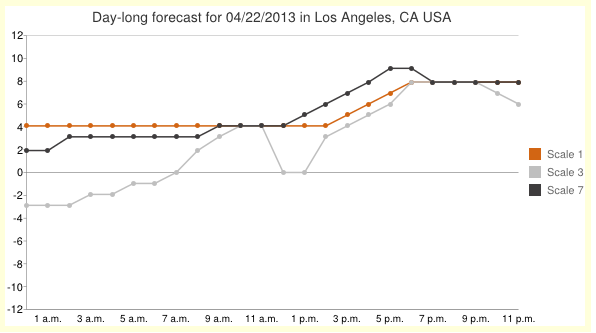 Sandy K. was buying a house. Her real estate agent called her and said that the closing would be scheduled for August 4. Sandy told the agent that she needed a minute to figure out her availability. After running a day-long forecast for August 4, Sandy saw that her scales 1 (self-esteem), 3 (communication), and 7 (self-control) were higher between 4 and 6 in the afternoon. This meant that she would feel confident in, there would be clear and accurate communication during the process, and that no legal mistakes or inaccuracies would be committed. Sandy scheduled the closing for 4 p.m. and the closing went very smoothly.
Sandy K. was buying a house. Her real estate agent called her and said that the closing would be scheduled for August 4. Sandy told the agent that she needed a minute to figure out her availability. After running a day-long forecast for August 4, Sandy saw that her scales 1 (self-esteem), 3 (communication), and 7 (self-control) were higher between 4 and 6 in the afternoon. This meant that she would feel confident in, there would be clear and accurate communication during the process, and that no legal mistakes or inaccuracies would be committed. Sandy scheduled the closing for 4 p.m. and the closing went very smoothly.
Asking for a raise - MONTH-LONG FORECAST
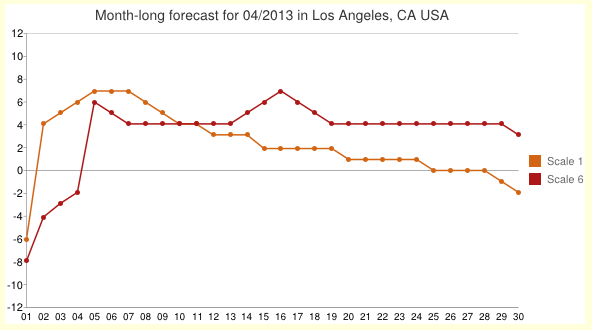 Mary S. wanted to ask her supervisor for a raise. She created a month-long forecast and saw that on Monday, scale 1 (self-esteem) was deep in the negative, which would mean that on that day she would not feel sufficiently confident to present her case. On Tuesday and Wednesday, scale 1 went into the positive area, but scale 6 (fairness, luck) went very low, which meant that even if she was confident in herself, she was not likely to get what she deserved. On Thursday, however, scales 1 and 6 were highly positive. That was the day she chose to speak with her boss. Several weeks later, Mary's raise was put into effect retroactively.
Mary S. wanted to ask her supervisor for a raise. She created a month-long forecast and saw that on Monday, scale 1 (self-esteem) was deep in the negative, which would mean that on that day she would not feel sufficiently confident to present her case. On Tuesday and Wednesday, scale 1 went into the positive area, but scale 6 (fairness, luck) went very low, which meant that even if she was confident in herself, she was not likely to get what she deserved. On Thursday, however, scales 1 and 6 were highly positive. That was the day she chose to speak with her boss. Several weeks later, Mary's raise was put into effect retroactively.
Exam - MONTH-LONG and DAY-LONG FORECAST
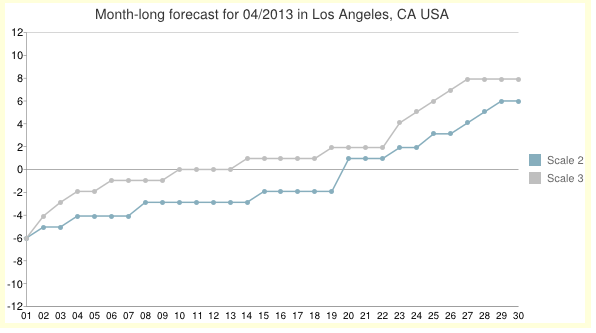 Martha H. was planning on taking an online exam. To select the best day, she created a month-long forecast. On April 27, scale 1 (self-esteem) and scale 3 (self-expression, learning) were somewhat law, which meant that she would not feel confident on the exam, and that she might have difficulty processing information and expressing herself well. Scale 6 (fairness, luck) was very low, showing that even if she did her best, she was likely to get a grade that would be lower than what she deserved. On April 29, however, scales 1, 3, and 6 were higher, which meant that she would feel more confident, provide good answers, and be fairly rewarded (get a good grade). While scale 6 continued to climb into May, Martha had to take the exam before the end of April, so she settled for the 29th.
Martha H. was planning on taking an online exam. To select the best day, she created a month-long forecast. On April 27, scale 1 (self-esteem) and scale 3 (self-expression, learning) were somewhat law, which meant that she would not feel confident on the exam, and that she might have difficulty processing information and expressing herself well. Scale 6 (fairness, luck) was very low, showing that even if she did her best, she was likely to get a grade that would be lower than what she deserved. On April 29, however, scales 1, 3, and 6 were higher, which meant that she would feel more confident, provide good answers, and be fairly rewarded (get a good grade). While scale 6 continued to climb into May, Martha had to take the exam before the end of April, so she settled for the 29th.
Martha then decided to select the best time of day for the exam. She created an individual daily forecast for April 29 and picked the time when scale 2 (emotional stability) and scale 3 (communication) were higher. Martha took the test at 10 a.m. on April 29 and passed it on the first try.
Planning a date - COMPARISON FORECAST
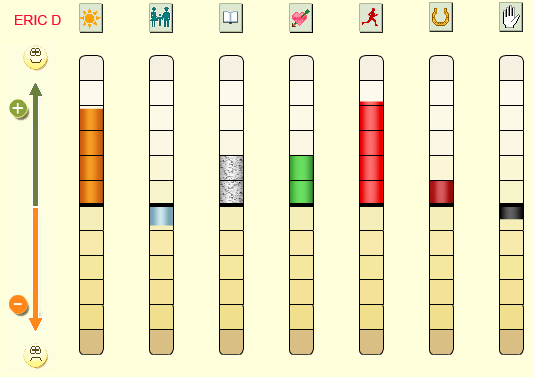
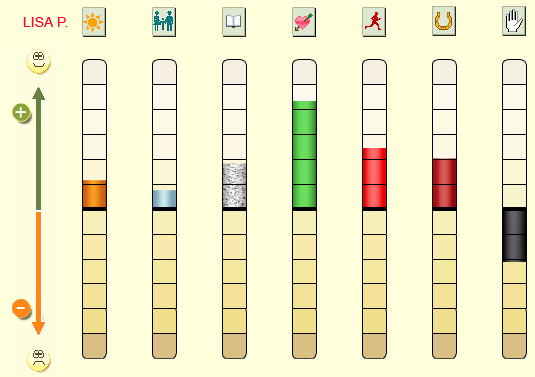 Eric D. had had a long crush on Lisa P. When he worked up the nerve to ask her on a date, he wanted to make sure it would go just right. To select the right time, he first created a day-long forecast for himself a picked a time that had the highest reading on scale 1 (self-confidence). This was going to be the time when he would talk to Lisa. He then created a comparison forecast for himself and Lisa. He wanted to see her on Friday night; however, he found that on Friday evening his scale 4 (magnetism) and scale 5 (energy) registered high. The same scales for Lisa, though, measured very low. This meant that if they met on Friday night, they would not develop a close emotional connection or have much sexual chemistry. On Monday night scales 4 and 5 were high for both of them, and even though it was an unusual night for a date, Eric took the chance. He called Lisa at the selected time, and not only did she agree to go out with him, the date went very well, and it became the beginning of serious relationship.
Eric D. had had a long crush on Lisa P. When he worked up the nerve to ask her on a date, he wanted to make sure it would go just right. To select the right time, he first created a day-long forecast for himself a picked a time that had the highest reading on scale 1 (self-confidence). This was going to be the time when he would talk to Lisa. He then created a comparison forecast for himself and Lisa. He wanted to see her on Friday night; however, he found that on Friday evening his scale 4 (magnetism) and scale 5 (energy) registered high. The same scales for Lisa, though, measured very low. This meant that if they met on Friday night, they would not develop a close emotional connection or have much sexual chemistry. On Monday night scales 4 and 5 were high for both of them, and even though it was an unusual night for a date, Eric took the chance. He called Lisa at the selected time, and not only did she agree to go out with him, the date went very well, and it became the beginning of serious relationship.







